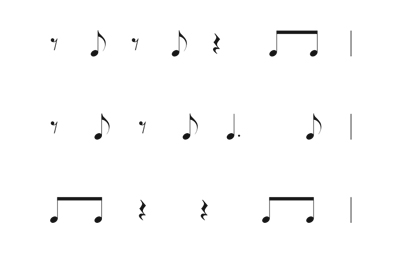Steve Massey from Foxboro (Massachusetts) High School, has a great expression: “A jazz program without an improvisation component has dubious merit.” He is right. Although improvisation can be taught in a big band setting, it is not the best use of ensemble time. A small group is much better for improvisation; all that is needed is you, a few students, and a play-along recording. Even if none of the students know how to improvise, it is easy to get them started. As an added bonus, teaching improvisation in a combo setting gives you a strong core group you can plug back into the big band.
The First Day
In the earliest stages the key is convincing students that improvisation is something at which they can be successful. To do this, start with what students know, such as a Bb major scale. I give them the notes of the major pentatonic, explaining that this is just the same scale they play in band every day, but with no fourth or seventh scale degree, and tell students they can do whatever they want, but they are limited to those notes. If you assign the Bb major pentatonic over a repeated Bb chord and students stay within the pentatonic, there are no wrong notes. In addition, I limit students to two measures at a time to get everyone playing right off the bat.
This gives students immediate success, and they realize from the beginning that they can improvise. With extremely reluctant students, I give them Bb and either C or D, and have them create a solo using those two notes. This is usually enough of a limitation that even the shyest students succeed. It is sometimes a matter of getting over a psychological wall that students have. I have never had a situation where a student has not been able to improvise at the end of a session with that information.
Chord Changes
Start by picking an easy blues, such as Blues by Five or Sonnymoon for Two, and continue using the major pentatonic. Avoid the blues scale for a while, as the clash with the basic harmony in the blues prevents the students from realizing that the blues, indeed, does have a chord progression. The IV chord in the fifth measure is a critical harmonic signpost.
The importance of this hit me when listening to an honor band play round robin on the blues. Out of 18 students, only four of them hit the IV chord. None of the rest of them seemed to recognize that there was harmony in the blues. This showed me that it’s not the players – they were great players – or the teachers, but rather the focus of what the teaching has been. We place great importance on catching chord changes.
When we get to the IV chord in the fifth measure, we use what I call root default, which is only playing the root of the current chord. For example, in Bb blues, students would use the major pentatonic over the first four bars and then play Eb, the root of the chord, in the fifth measure. After that is established, students can move merrily on their way. The aim is for students to understand that the blues has harmony and that the IV chord is critical. I want students to develop an ear for that.
I avoid explaining root default as Eb in the original key or referring to it the fourth scale degree. Root default means playing the root of the current chord. If you explain it as the fourth scale degree, you get into using the whole major scale, and we want to avoid the fourth and seventh scale degrees at this stage in the game; it’s a little too early.
Do the same for measure nine, which is often either the only minor chord in a major blues, or a V. If it is a blues like Freddie Freeloader with a V to IV progression, we use root default on the V, then slide down to the IV chord, which is also root default. What’s great about sticking to the roots of chords for anything other than a I chord is that students start to hear the harmony sliding down, which is a characteristic sound in the blues. If students can hear that, then you have three harmonic signposts in the blues.
If the ninth measure has a minor ii chord, I have students use root default again, but then I teach them about the third of the ii chord. Although I prefer to stick with root default in most cases, the third of the ii chord is a great landing note. Some students will stay with the root default, while others get more adventurous and are willing to try the third. Even at this stage in the game, students are starting to fill in the blanks a little, but it is not too much information for them. In addition, students now know the harmonic framework for the blues.
Adding Scales for the Blues
Limiting students to these signposts plus the major pentatonic scale keeps things manageable. Later the dominant scale or minor pentatonic can be added. When moving to these scales, I explain that one characteristic of the blues is the flat third, but that it only applies to the blues; in another context, the third is not lowered. It is important that students understand that. The minor pentatonic is a specific application, and one of the common mistakes I have seen is that the blues can make students blind to the harmony. I have seen good players try to play over dominant chords in standard tunes using the blues scale. It doesn’t sound right. Students should learn early that the minor pentatonic and the flattened third are only used in a specific context.
Bass Players
Although music may include suggested bass lines, it might be better to teach the bass player to read changes and create bass lines. Even if a bass player reads only tabs, that player can function in combo without needing to read a note of music. West Coast bass player Tom Warrington suggests that the bassist play four roots per measure, so the harmony is established. Then, teach approach tones; on the I chord, play Bb for three beats, with a D on beat four. This leads beautifully into the root of the IV chord, Eb. You can then add a leading tone on beat two, creating a line that is Bb, A, Bb, D, or put a fifth on beat two to produce a bass line that is a little more involved. Avoid having the bassist simply run an eighth-note scalar walking line. At this stage, this doesn’t define the harmony well enough.
Pianists and Guitarists
A common problem with written jazz charts is that the piano parts are much more difficult than jazz piano should be. The texture is much too thick, because the piano part frequently voices the full ensemble chord for two-hand piano. Even students who are excellent classical piano players can get discouraged trying to play written charts that jump all over the piano. If you give students a few simple voicings and limit them to comping rhythms, they will have much more initial success and learn to think about jazz piano as they ought.
All a pianist (or a guitarist) initially needs is right-hand shell voicings – the third and seventh of the chord. Adding the root to those two produces what is called a closed shell voicing, but the bass is covering the root, so it is unnecessary for the pianist to cover it. Another interesting shell sound is the third and the ninth. On a Bb7 chord, playing D and the adjacent C produces a simple, but hip, sound.
At first I have piano players play whole notes. The role of the piano player, whether in a big band or a combo, is in the solo section, so I like to think of comping rhythms as a conversation with the soloist. Below are rhythmic patterns pianists can handle if the voicings are easy enough.

Drummers
The first step with most inexperienced drummers is vocabulary removal. Take away the bass drum pedal and have the student play an unadorned straight quarter-note pattern on the ride cymbal while also hitting beats two and four on the hi-hat. Fills should delineate the architecture; in a 12-bar blues, start with a simple fill on bar 12 to delineate the return to bar one. Keep fills simple. A good start is quarter notes down the kit – cymbal on one, snare on two, tom on three, and bass on four. Sonny Payne made a career of such fills with Count Basie.
Later you can vary the ride pattern with quarter, two eighths, quarter, two eighths. Make sure the drummer understands the difference between time solos and actual solos.
The Next Step
Good tunes for beginning combo (and, by all means, teach these by ear) include Saints Go Marchin’ In, Little Sunflower, St. Thomas, Tenor Madness, Red’s Good Groove, One for Daddy-O, and Blues in the Closet, Summertime, Blues for My Father, Autumn Leaves, I’ve Grown Accustomed to Your Face, and I Can’t Get Started.
As a jazz educator, when I started teaching improvisation, I felt rudderless and a little hopeless. What kept me going was my students’ thirst for knowledge and my realization that I had to get better – for them and for myself as a teacher. These techniques will work and prove that you can teach jazz well.
* * *
Suggested Books for Beginning Combos
Maiden Voyage
By Jamey Aebersold
This is Volume 54 of the series, which now numbers over 100 play-along disks with written tunes. This volume has 14 standard tunes, most of which are readily accessible to beginning improvisers. Another useful Aebersold volume for beginning improvisers is Volume 24, Major and Minor. Each cut is in one key, so you can teach students a major pentatonic and turn them loose. (Jamey Aebersold Jazz)
Cutting the Changes
By Antonio Garcia
This is a landmark work that allows students to improvise over 13 standard tunes using only major scales. In the initial presentation, Garcia removes the chord changes to free improvisers to think melodically rather than vertically. This approach is excellent in eliminating the glass ceiling that has students playing mathematically rather than expressively. (Kjos)
The Real Easy Book
By Chuck Sher and Sher Music
This is superior teaching material for beginning combo players. There are 42 standard tunes, many of which can be taught in conjunction with published big band charts. This is a great way to develop soloists for big band. An excellent feature of this series is the help it gives students and teachers with rhythm section – simple, good piano voicings (three-note and rootless), sample bass lines, and useful scales. (Sher Music)
The Real Book
There are over 400 tunes in this book, which is sold in various keys. Books of this sort (legal and illegal) have been around for years, but this set is considerably cleaned up and more accurate. The latest Real Books include recorded accompaniment for every tune. (Hal Leonard)






